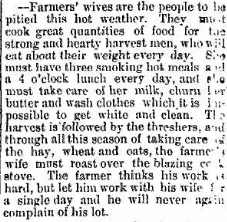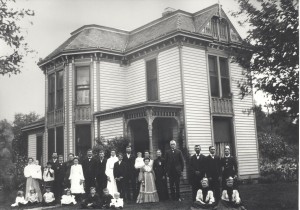Workday Wednesday: Ella V. Daniel- A Day in the Life of a Farm Wife, Part 2

Daniel Family, Roberts Family (Click for Family Tree)
Some seasons were more labor intense for everyone on the farm, and especially for a farm wife like Ella V. Daniel Roberts. Her daughter, Edith Roberts Luck detailed this in stories and letters about her family:
Mother worked all summer canning and pickling and being like a squirrel getting in winter supplies. Dad (George Anthony Roberts, Sr.) was pretty smart. We had enough strawberries and cherries and other small fruit so that someone in the neighborhood came in and picked on the shares. Even then I can still those [?] cans of berries that had to be stemmed or cherries pitted. Sometimes we used a cherry pitter but mother was a bit skeptical of that as some of the cherries might have a worm in them.
Dad also fixed up a place in the old house… where mother could use a gasoline engine for washing and churning and Dad could use it for cleaning seeds. It was a shaft with belts going over the pulleys and out a window where the engine was housed. He was very ingenious. He made a cistern next to the house and water could be pumped into the house and then into the sink. It was on the east side of the kitchen. Next to the stove. If you wanted hot water, rather warm, you got it out of the reservoir attached to the range or stove on the south wall.
Oh yes, Dad sharpened knives and scissors on this set up in the old house. He could not stand a dull tool.
Although they had an inventive setup, making life a bit easier than in other farmhouses, life was still full of tasks. Processing the farm’s produce, canning, and cooking were hot and time-consuming tasks. When a home was being built, as in the excerpt below, or if it was planting, harvest, or threshing season, there would be many more mouths to feed.
Can you imagine mother cooking for all those workmen, a dozen or so in all that mess. I would have to stand and shoo the flies off the table with a branch from one of the trees. Hot, oh it was so hot. Not small wonder that she died at 52 years of age. The men slept in the old house and when she churned she would call to them when she had gathered butter and they would come from all directions to get the fresh buttermilk. The men cleaned up out side at a bench with towels and soap ready. Just imagine the work she had to do.
This meal for the workmen would be a meat and potato meal. Vegetables two or three of them and pickles and jam and relishes. Pie and cake and bread that she baked herself with coffee and tea and milk. Sister at that time was a teenager and did help but mother never did have hired help unless she was sick. Come to think of it, I cannot remember her ever having help. Now the neighbor women came in at threshing time or other times when there were men to cook for but never paid help.
Edith reported that her mother was a kind and loving soul, and very hardworking, but,
There were two chores that irked mother…
[One] thing that mother had a hang up about was having supper before the chores were finished. You see in the fall and winter and spring too, everything was done by the men before they came in to supper. In the summer mother wanted to have a little daylight for her to work out in her garden after supper. I can see both sides and always it was a bit of a thing.
“Dinner” was the noontime meal, and was the biggest meal of the day since everyone had been up working at dawn (or before) and still had many hours of chores left. “Supper” was a lighter, evening meal, so a little less work for Ellie Roberts. They did sometimes have company though, such as the man that George Roberts bought his first car (a Rambler) from, in the big city of Des Moines, Iowa:
The dealer and his family came to see us often. Mostly at the evening meal. I know he just came for a good country meal. Suppers were mostly leftovers and with company it was pretty scarce for us kids. Mr. Miles would say ”he could not make his bread and jam come out even” so he would eat on. I don’t blame him as mother’s apple and plum butter and homemade biscuits were delicious.
George Sr. and Jr. plus their hired hand would have gotten their usual portions of food, since they worked hard on the farm. The women and children would share the leftover leftovers.
Winter comes early in Iowa, and keeping the fruits of the year’s labors protected was important, as was heat for the house. We are so lucky to be able to flip a switch from ‘cool’ to ‘heat’ or our programable thermostats do it automagically. Not so in the early 1900s and before, as Edith describes the second chore that irked her dear mother:
She would have to talk and talk to get Dad to put up the stoves in the two front rooms. She would polish them with black stove polish, her hands would not be free of it for days. Then the stove pipes would have to be fitted. The piece of metal that covered the opening during the summer would have to come out with a lot of soot and a big metal piece put down for the stove to set on. Well it all added up to stress for sure. The stove in the parlor had to be put up because of the fruit and vegetables in the cellar under this room. Much of mothers summer work had to be protected from the freezing weather. It was a much nicer stove than the one in the sitting room. It had [isinglass] or mica you could see thru and we burned anthracite coal. That is what is called hard coal. The embers burn a long time seemingly with out flames or smoke. It was fun to sit on the floor and just watch the burning coals thru this glass. The ashes had to be taken out each morning in the other stove and I am not sure how often in the parlor stove as it was much cleaner and needed less attention.
Illnesses, of course, clustered into preferred seasons, and a farm wife had to be prepared to treat everything from poison ivy to assisting with childbirth:
In the neighborhood mother had the reputation of being very good at helping the doctors when emergencies came up. In this same house where Ruby was born mother helped deliver a child that was a real hard case. When there was illness in the neighborhood they would call for mother. Just being around her would instill confidence and trust.
To be continued…
Notes, Sources, and References:
1) Excerpts in green are from letters and stories written by Edith Roberts Luck. They are protected under copyright law since she wrote them in the 1970s and 80s, so may not be published or posted elsewhere. Family members may request permission to republish for non-profit use; please use our contact form.
2) Ruby Robinson DeMoss was the child of Ethel Gay Roberts Robinson, Edith’s sister.
Please contact us if you would like higher resolution images. Click to enlarge images.
We would love to read your thoughts and comments about this post (see form below), and thank you for your time! All comments are moderated, however, due to the high intelligence and persistence of spammers/hackers who really should be putting their smarts to use for the public good instead of spamming our little blog.